Special Report
Cities Where Having a Job Doesn’t Keep You Out of Poverty

Published:
Last Updated:

While the U.S. unemployment rate reached 3.6% in April 2019, its lowest point since December 1969, many full-time workers in America struggle to stay out of poverty. Nationwide, some 3.1 million full-time workers, or 3% of all full-time workers, are considered working poor — individuals who work full-time, year-round jobs and earn incomes below the poverty line.
So while having a full-time job certainly lowers the likelihood of living in poverty, it is no guarantee. For reference, the general poverty rate is 14.6%.
To determine the cities where having a job does not keep you out of poverty, 24/7 Wall St. measured the ratio of the official poverty rate in each metro area to that area’s poverty rate among full-time, year-round workers aged 16 to 64. Nationwide, Americans with a full-time, year-round job are 4.9 times less likely than the general public to live in poverty.
Among cities on this list, having a job is less advantageous, and full-time workers are between 3.6 times less likely to only twice as likely to stay out of poverty as the general public.
Of the 20 cities on this list, five are in Texas and three are in Louisiana. Florida, Idaho, and Georgia are each home to two, and Alabama, California, New Mexico, North Carolina, South Carolina, and Utah are each home to one. Many of these places are in states also represented on our list of states with the worst economies.
Metro economies with high poverty rates among full-time workers tend to have large shares of workers employed in some of the lowest paying jobs in America. Some of the lowest paying sectors in the United States include leisure and hospitality, trade, transportation, utilities, and education and health services.
Click here to see the cities where having a job doesn’t keep you out of poverty
Click here to read our methodology

20. Bakersfield, CA
> Poverty rate of full-time workforce: 6.3%
> Official poverty rate: 22.6% (top 10%)
> June 2019 unemployment rate: 8.0% (top 10%)
> Avg. workweek: 39.0 hours (top 40%)
While nationwide, Americans who work full-time, year-round are 4.9 times less likely to be in poverty than the general public, in Bakersfield, full-time workers are only 3.6 times less likely to live below the poverty line. One reason for the relatively high rate of working poverty in the city may be the large number of low-wage agricultural jobs.
Some 19.1% of workers in Bakersfield are employed in agriculture, the fifth largest share in the nation. The average agricultural worker earns just $562 a week, among the least of any metropolitan agricultural sector and less than half the $1,101 average weekly wage for all U.S. workers.
[in-text-ad]

19. Dalton, GA
> Poverty rate of full-time workforce: 5.3%
> Official poverty rate: 18.9% (top 20%)
> June 2019 unemployment rate: 4.6% (top 20%)
> Avg. workweek: 38.7 hours (top 40%)
Dalton is one of many manufacturing-dependent metro areas in the South with a large share of working adults living in poverty. Some 43.6% of workers in Dalton are employed in the manufacturing sector, the fifth largest share of any U.S. city. The average wage for manufacturing workers in Dalton is just $850 a week, far less than both the average of $1,318 for the sector nationwide and the average of $1,101 for all U.S. workers.
An estimated 5.3% of Dalton residents who work full-time live in poverty, about one-fourth the 18.9% poverty rate for all residents. Nationwide, the 3.0% working poverty rate is roughly one-fifth the 14.6% official poverty rate.

18. Hilton Head Island-Bluffton-Beaufort, SC
> Poverty rate of full-time workforce: 3.8%
> Official poverty rate: 13.4% (bottom 40%)
> June 2019 unemployment rate: 3.2% (bottom 30%)
> Avg. workweek: 39.9 hours (top 10%)
A vacation destination for roughly 2.7 million visitors every year, the Hilton Head Island metro area is one of several tourist hubs where a relatively large share of full-time workers live in poverty because of low-wage jobs. Some 15.6% of the Hilton Head workforce is employed in the leisure and hospitality sector, the seventh largest share of any metro area. The average worker in leisure and hospitality earns just $430 a week, less than half the $1,101 average weekly wage for workers across all industries nationwide. Leisure and hospitality is another sector that can pay full-time workers poverty wages.
While nationwide, Americans who work full-time year-round are 4.9 times less likely to be in poverty than the general public, in Hilton Head, full-time workers are only 3.5 times less likely to live below the poverty line.

17. Lake Charles, LA
> Poverty rate of full-time workforce: 4.7%
> Official poverty rate: 16.5% (top 40%)
> June 2019 unemployment rate: 3.5% (bottom 50%)
> Avg. workweek: 39.7 hours (top 20%)
Full- and part-time workers in Lake Charles work for an average of 39.7 hours a week — a full hour longer than the national figure. Despite the longer workweek, 4.7% of full-time, year-round workers in Lake Charles live in poverty, far more than the 3.0% national working poverty rate.
One factor contributing to the relatively large share of working poor in Lake Charles may be the population’s low educational attainment. Areas with low educational attainment are less likely to attract advanced industries and often have relatively few high-wage jobs available. Just 21.4% of adults in Lake Charles have a bachelor’s degree, far less than the 30.9% national rate.

16. Coeur d’Alene, ID
> Poverty rate of full-time workforce: 3.6%
> Official poverty rate: 12.6% (bottom 30%)
> June 2019 unemployment rate: 3.5% (bottom 50%)
> Avg. workweek: 37.9 hours (bottom 40%)
Situated on the northern shore of Lake Coeur d’Alene, the Coeur d’Alene metro area is one of several resort towns where low-wage jobs keep a relatively large share of full-time workers in poverty. Some 8.8% of the Coeur d’Alene workforce is employed in the leisure and hospitality sector, far more than the 5.5% national figure. The average wage of hospitality workers is just $355 a week, far less than the weekly average wage of $1,101 for workers across all industries nationwide and a poverty wage for a family of three in 2019.
While nationwide, Americans who work full-time, year-round jobs are 4.9 times less likely to be in poverty than the general population, in Coeur d’Alene full-time workers are only 3.5 times less likely to live below the poverty line
[in-text-ad]

15. Goldsboro, NC
> Poverty rate of full-time workforce: 6.1%
> Official poverty rate: 21.2% (top 10%)
> June 2019 unemployment rate: 4.4% (top 30%)
> Avg. workweek: 39.5 hours (top 20%)
In Goldsboro, just 19.7% of adults have a bachelor’s degree, far less than the 30.9% national college attainment rate. Individuals without a college degree are less likely to have high-paying jobs, and areas with low educational attainment tend to have fewer high-paying industries like information and finance. In Goldsboro, just 0.6% of the workforce is employed in the information sector, a fraction of the 4.5% national share. Some 5.3% of workers are employed in finance, less than half the 11.0% national figure.
The average worker in Goldsboro earns just $720 a week, $381 less than the average earnings for all U.S. workers. An estimated 6.1% of full-time, year-round workers live in poverty, more than twice the 3.0% national working poverty rate.

14. Alexandria, LA
> Poverty rate of full-time workforce: 5.7%
> Official poverty rate: 19.6% (top 20%)
> June 2019 unemployment rate: 4.7% (top 20%)
> Avg. workweek: 40.1 hours (top 10%)
Two factors contributing to the large share of working poor in Alexandria may be low educational attainment and a lack of advanced, high-paying industry. Just 18.3% of adults in Alexandria have a bachelor’s degree, far less than the 30.9% national college attainment rate. Areas with low educational attainment are less likely to attract advanced, high-wage industries like information and finance. In Alexandria, 1.0% of the workforce is employed in information, far less than the 4.5% national share. Some 5.2% of workers have jobs in the financial activities sector, less than half the 11.0% national figure.
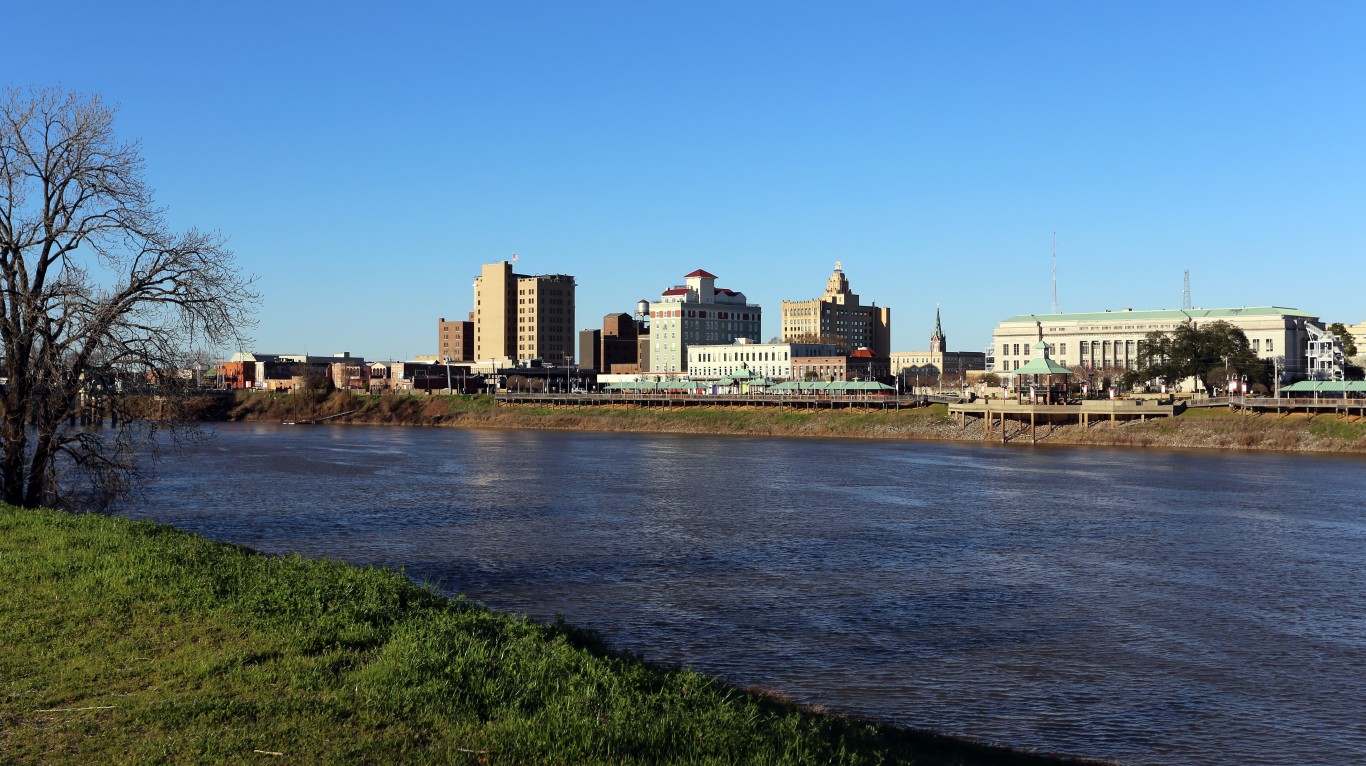
13. Monroe, LA
> Poverty rate of full-time workforce: 7.1%
> Official poverty rate: 24.2% (top 10%)
> June 2019 unemployment rate: 4.9% (top 20%)
> Avg. workweek: 38.6 hours (top 50%)
Monroe is one of several metro areas in Louisiana with poor economic conditions where having a full-time job does not guarantee living above poverty level. Just 22.8% of adults in Monroe have a bachelor’s degree, far less than the 30.9% national rate. Due to the presence of low-wage industries, the average worker in Monroe earns just $766 a week, $335 less than the U.S. average.
Of the estimated 20,097 adults with a full-time, year-round job in Monroe, 7.1% live in poverty — more than twice the 3.0% national working poverty rate and the fifth highest working poverty rate of any U.S. metro area.
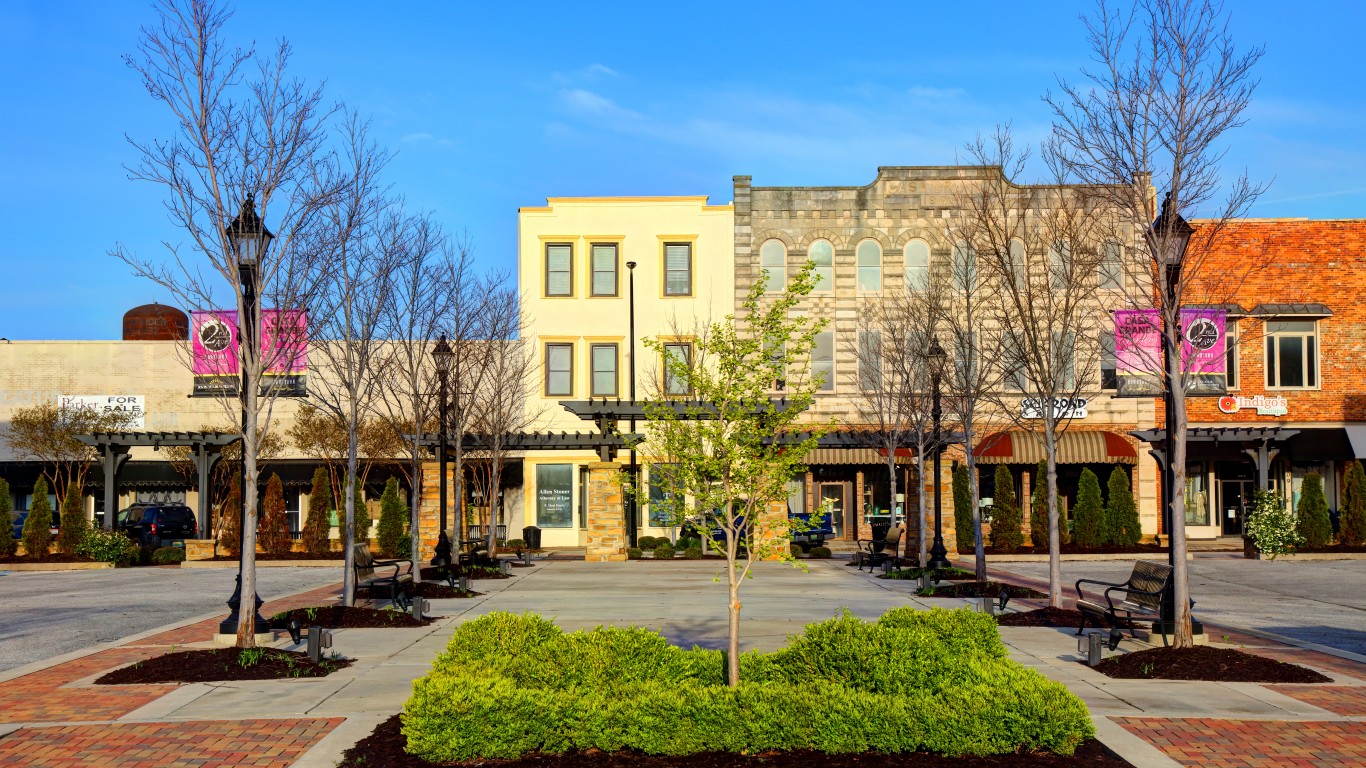
12. Decatur, AL
> Poverty rate of full-time workforce: 4.9%
> Official poverty rate: 16.6% (top 40%)
> June 2019 unemployment rate: 3.1% (bottom 30%)
> Avg. workweek: 38.4 hours (bottom 50%)
Just 18.5% of adults in Decatur have a bachelor’s degree, far less than the 30.9% national college attainment rate. Areas with low educational attainment are less likely to attract advanced, high-wage industries like information and finance. In Decatur, 0.6% of workers are employed in the information sector, a fraction of the 4.5% national share. Some 4.8% work in finance, less than half the 11.0% of U.S. workers employed in the sector nationwide.
The lack of high-wage industries may diminish the advantage of having a full-time job in the struggle to stay out of poverty. While nationwide, having a full-time, year-round job makes one 4.9 times more likely to live above the poverty line than the general population, in Decatur full-time workers are just 3.4 times as likely to not live in poverty.
[in-text-ad]
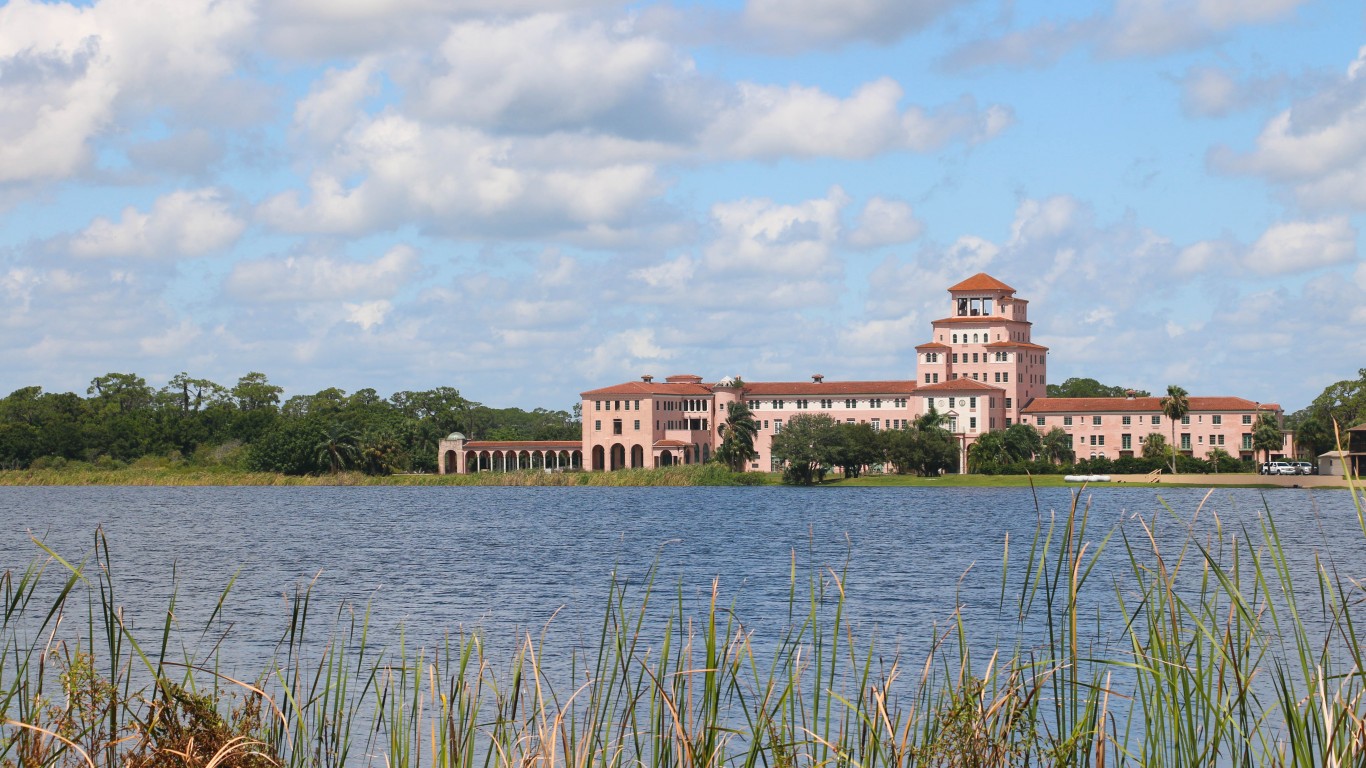
11. Sebring, FL
> Poverty rate of full-time workforce: 5.7%
> Official poverty rate: 18.7% (top 20%)
> June 2019 unemployment rate: 5.1% (top 20%)
> Avg. workweek: 37.8 hours (bottom 30%)
Located in south central Florida, Sebring is one of America’s poorest cities. The typical household earns just $36,374 a year, the second lowest median household income of any U.S. metro area. Some 5.1% of the workforce is unemployed, and 18.7% of residents live in poverty — each among the highest such figures of any city.
Even those fortunate enough to have a full-time job in Sebring struggle to stay out of poverty. An estimated 5.7% of workers with full-time, year-round jobs in Sebring live below the poverty line, the 11th highest working poverty rate of any city.

10. Amarillo, TX
> Poverty rate of full-time workforce: 4.6%
> Official poverty rate: 15.0% (bottom 50%)
> June 2019 unemployment rate: 2.5% (bottom 10%)
> Avg. workweek: 40.0 hours (top 10%)
While having a job increases the likelihood of living above the poverty line by 4.9 times nationwide, in Amarillo a full-time job increases the likelihood of not being poor by just 3.3 times. Some 4.6% of the full-time workforce in Amarillo lives in poverty, compared to the 15.0% poverty rate for all residents of the metro area. Nationwide, 3.0% of the full-time workforce lives in poverty, and the national poverty rate is 14.6%.
One factor that may be contributing to the relatively small difference between the working and official poverty rates in Amarillo may be the low educational attainment. Areas with low educational attainment are less likely to attract advanced industries, and often have few high-wage jobs available. Some 23.5% of adults in Amarillo have a college degree, far less than the 30.9% national rate.

9. Gainesville, GA
> Poverty rate of full-time workforce: 5.2%
> Official poverty rate: 16.1% (top 40%)
> June 2019 unemployment rate: 3.0% (bottom 20%)
> Avg. workweek: 39.8 hours (top 10%)
Gainesville is one of many manufacturing-dependent metro areas in the South where a large share of working adults live in poverty. An estimated 25.1% of workers in Gainesville are employed in the manufacturing sector, more than twice the 12.2% national share. The average manufacturing worker in Gainesville earns just $879 a week, far less than both the $1,318 average for the sector nationwide and the $1,101 average for all U.S. workers.
Some 5.2% of Gainesville residents who work full-time live in poverty, about one-third the 16.1% poverty rate for all residents. Nationwide, the 3.0% working poverty rate is nearly one-fifth the 14.6% official poverty rate.

8. Laredo, TX
> Poverty rate of full-time workforce: 10.2%
> Official poverty rate: 31.5% (top 10%)
> June 2019 unemployment rate: 3.6% (bottom 50%)
> Avg. workweek: 38.8 hours (top 40%)
While nationwide having a full-time, year-round job makes one 4.9 times more likely to live below the poverty line than the general population, in Laredo, full-time workers are just 3.1 times as likely to not live in poverty.
One factor diminishing the advantage of having a full-time job in the struggle to stay out of poverty in Laredo is the abundance of low-wage jobs in the city. Located along the U.S.-Mexico border, Laredo is the nation’s busiest inland trade port in terms of the total value of goods imported and exported. Some 43.5% of workers are employed in the trade, transportation, and utilities sector — the largest share of any city. Workers in the sector earn an average wage of just $690 a week, $411 less than the average wage for all workers nationwide.
[in-text-ad]
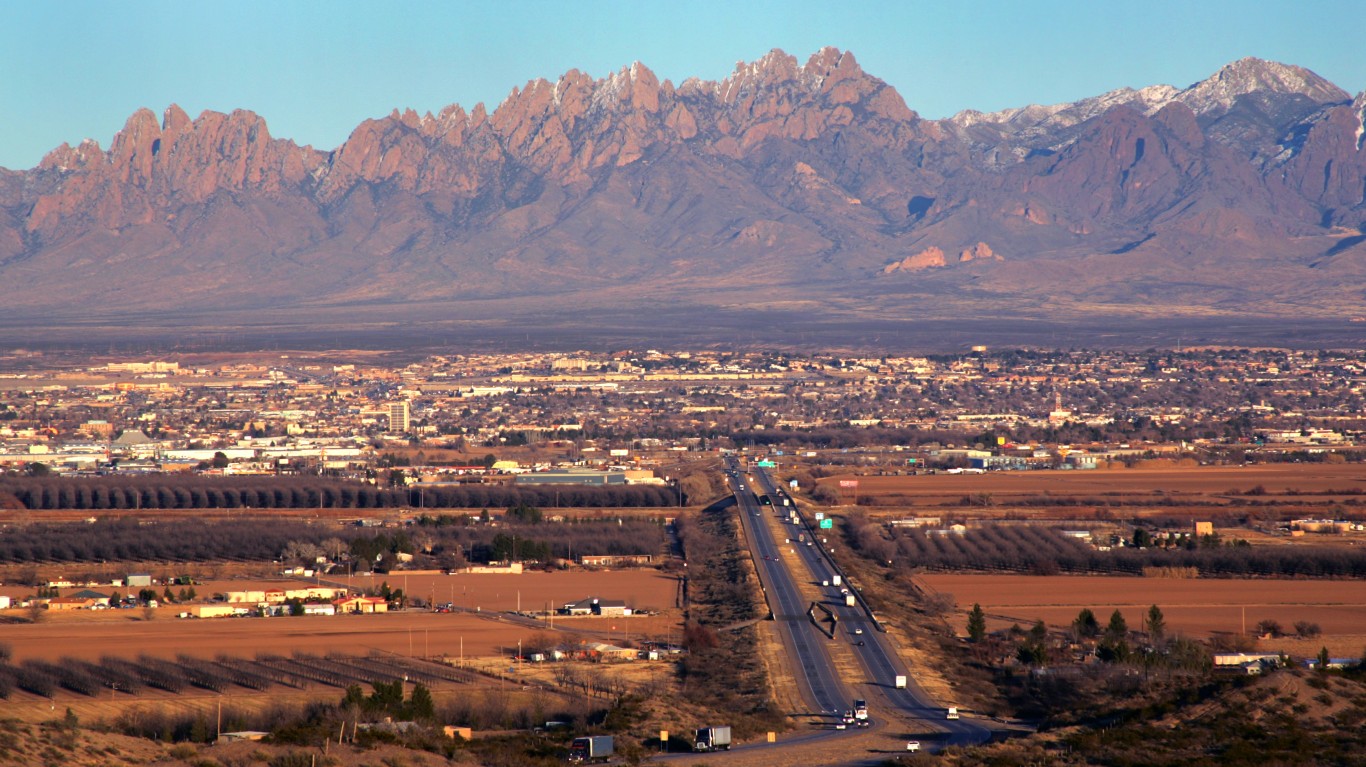
7. Las Cruces, NM
> Poverty rate of full-time workforce: 9.2%
> Official poverty rate: 27.9% (top 10%)
> June 2019 unemployment rate: 5.6% (top 10%)
> Avg. workweek: 37.2 hours (bottom 20%)
Las Cruces is one of the poorest metro areas in the country. The typical Las Cruces household earns $18,538 less a year than the U.S. median, and 27.9% of residents live in poverty — the fourth highest poverty rate of any city. Some 5.6% of the workforce is unemployed, far more than the 3.7% national unemployment rate.
Even those with a job in Las Cruces struggle more than the average U.S. worker to stay out of poverty. Among the 55,160 adults with a full-time, year-round job in Las Cruces, 9.2% live below the poverty line — more than three times the national working poverty rate.

6. St. George, UT
> Poverty rate of full-time workforce: 4.7%
> Official poverty rate: 14.2% (bottom 40%)
> June 2019 unemployment rate: 3.1% (bottom 30%)
> Avg. workweek: 36.3 hours (bottom 10%)
While increased tourist activity in St. George has fueled economic growth in the metro area in recent years, low-wage jobs in the industry may be one reason why relatively many full-time workers in the metro area live in poverty. Some 8.0% of the St. George workforce is employed in leisure and hospitality, far more than the 5.5% national figure and one of the largest shares of any city. The average hospitality worker in St. George earns just $341 a week, less than one-third the $1,101 average earnings for all workers nationwide.
Overall, an estimated 4.7% of full-time, year-round workers in St. George live in poverty, higher than the 3.0% national working poverty rate and just about a third of the official poverty rate of 14.2% in the city.
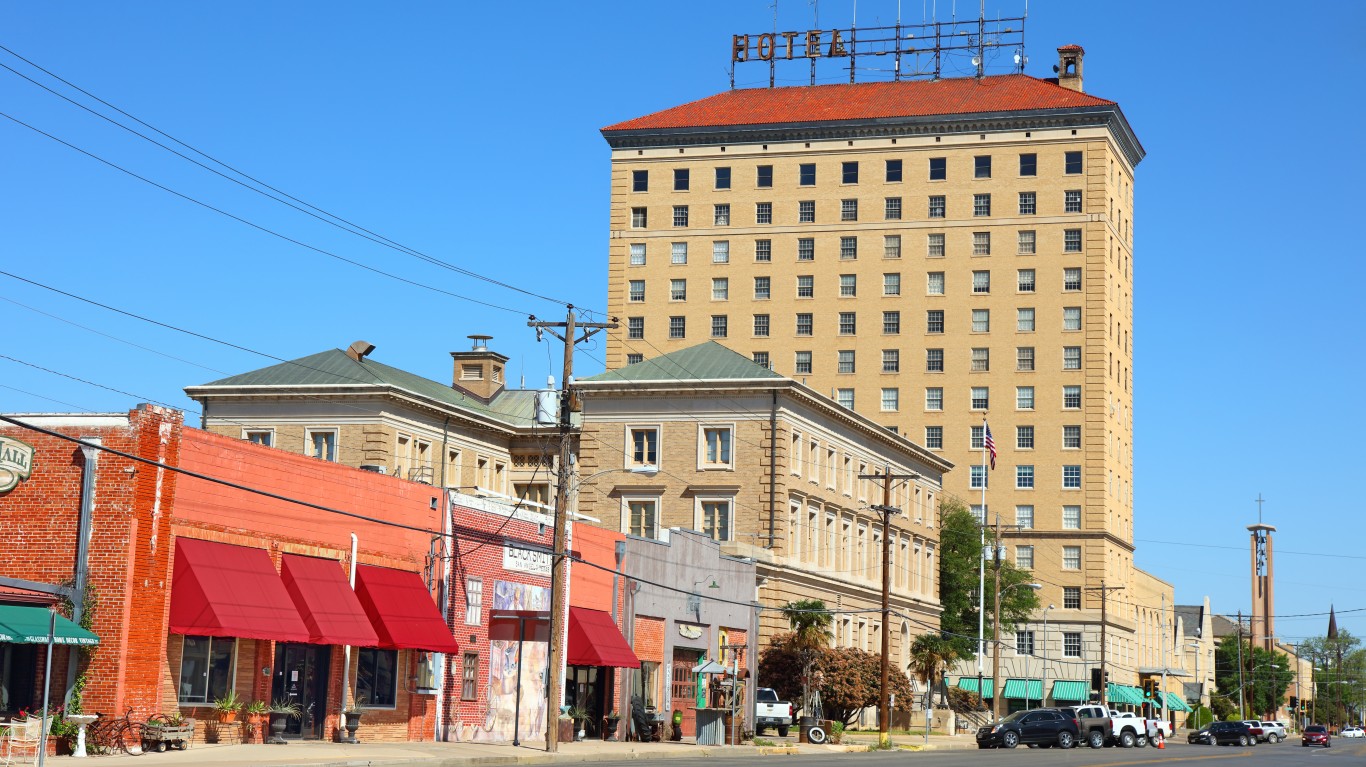
5. San Angelo, TX
> Poverty rate of full-time workforce: 4.4%
> Official poverty rate: 12.9% (bottom 30%)
> June 2019 unemployment rate: 2.9% (bottom 20%)
> Avg. workweek: 41.0 hours (top 10%)
The average workweek among full- and part-time workers in San Angelo is 41.0 hours — 2.3 hours longer than the U.S. average and the 12th longest workweek of any city. Despite the long hours, some 4.4% of full-time, year-round workers in San Angelo live in poverty, higher than the 3.0% national working poverty rate.
One factor contributing to the large share of working poor in San Angelo may be the lack of high-paying job opportunities in the metro area. While San Angelo is adjacent to the Permian Basin and has one of the largest natural resources and mining sectors of any city, relatively few workers are employed in other high-wage industries. Just 8.3% of workers have jobs in professional and business services, for example, less than half the 22.0% national share.
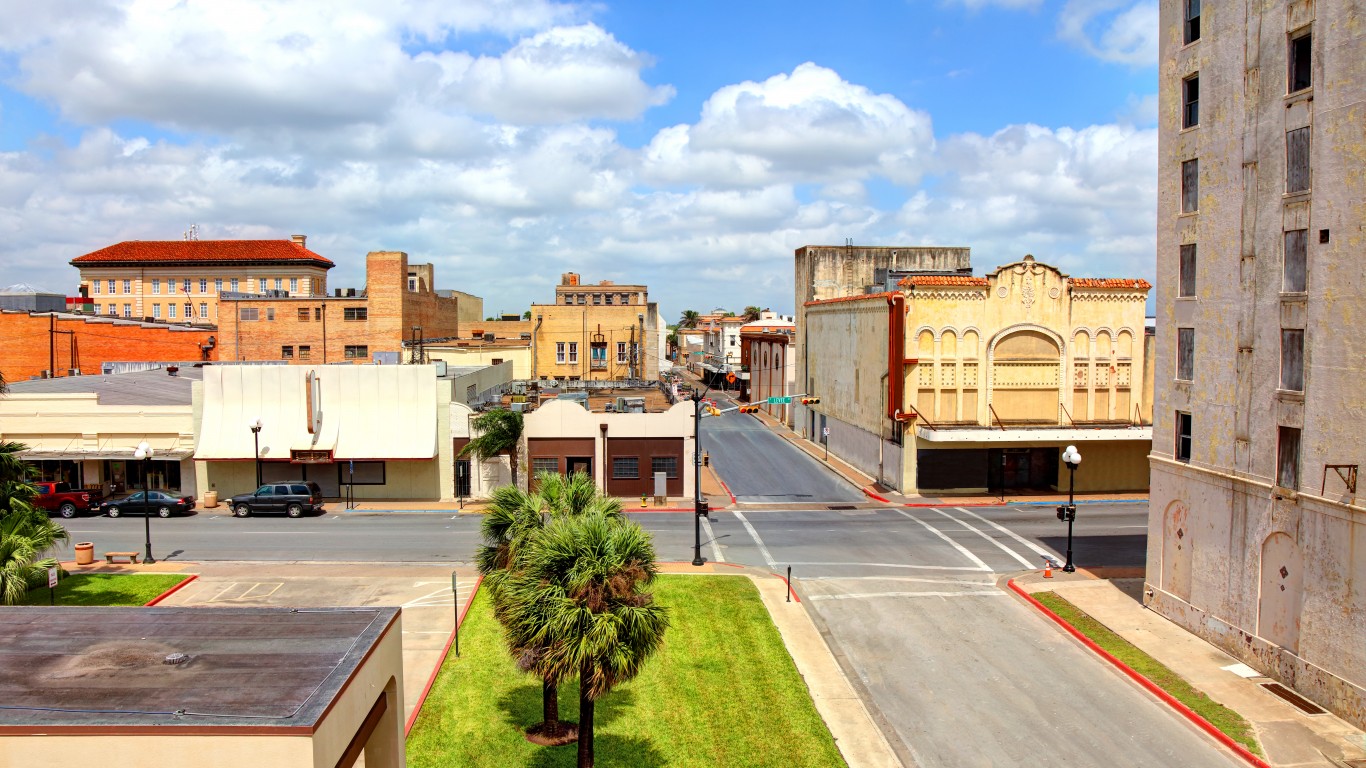
4. Brownsville-Harlingen, TX
> Poverty rate of full-time workforce: 10.8%
> Official poverty rate: 31.2% (top 10%)
> June 2019 unemployment rate: 5.4% (top 10%)
> Avg. workweek: 38.1 hours (bottom 40%)
Located in the southern tip of Texas along the U.S.-Mexico border, the Brownsville-Harlingen metro area is one of the poorest cities in the country. The typical household earns just $36,374 a year, the lowest median household income of any metro. Some 5.4% of the labor force is unemployed, and 31.2% of residents live in poverty — each among the highest such figures of any city.
Even residents with full-time jobs in Brownsville struggle with poverty. Of the estimated 103,936 adults with full-time, year-round jobs in Brownsville, 10.8% live below the poverty line — more than three times the 3.0% national working poverty rate.

3. Idaho Falls, ID
> Poverty rate of full-time workforce: 4.0%
> Official poverty rate: 11.5% (bottom 20%)
> June 2019 unemployment rate: 2.3% (bottom 10%)
> Avg. workweek: 38.0 hours (bottom 40%)
Located along the Snake River between Grand Teton National Park and Sawtooth National Forest, Idaho Falls is one of several small, tourist-friendly metro areas with low income inequality, where the difference in the likelihood of living in poverty between those with and without a job is relatively small. While nationwide, Americans with a full-time, year-round job are 4.9 times as likely to not live in poverty as the general public, in Idaho Falls, full-time workers are just 2.9 times as likely to not live in poverty.
Similarly, while nationwide individuals with a college degree are 5.9 times as likely as those who did not graduate from high school to not live in poverty, in Idaho Falls, college graduates are just 3.1 times as likely to not be in poverty — the fifth smallest difference of any city.
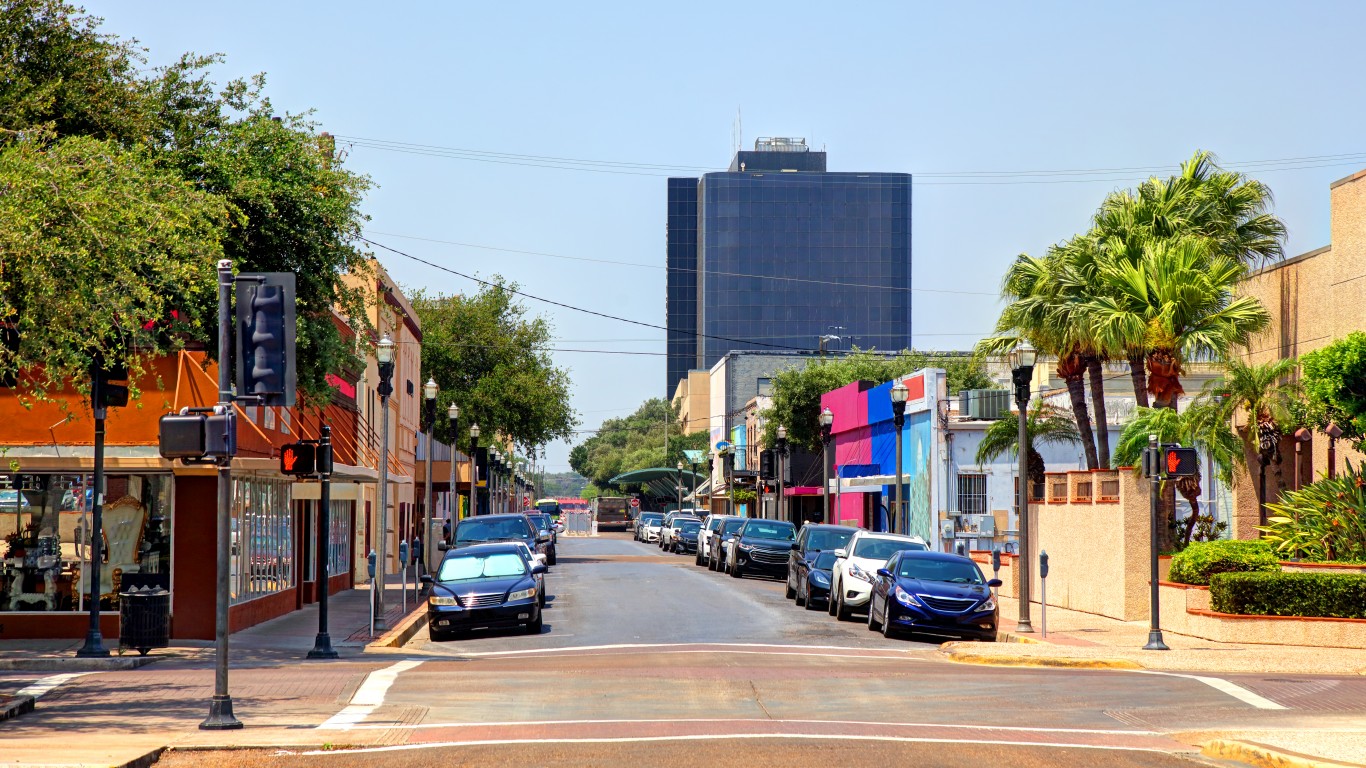
2. McAllen-Edinburg-Mission, TX
> Poverty rate of full-time workforce: 11.3%
> Official poverty rate: 31.8% (top 10%)
> June 2019 unemployment rate: 5.9% (top 10%)
> Avg. workweek: 39.2 hours (top 30%)
Located on the U.S.-Mexico border, the McAllen-Edinburg-Mission metro area is a major port of trade. Some 28.5% of workers are employed in the trade, transportation, and utilities sector, the 12th largest share of any city. The average trade worker in the metro area earns just $649 a week, $267 below the average for the sector nationwide and $452 below the average earnings for all U.S. workers.
The prevalence of low-wage industries and other poor economic conditions leave many full-time workers in McAllen struggling to stay out of poverty. Of the 203,360 workers with full-time, year-round jobs in McAllen, 11.3% live below the poverty line — more than three times the 3.0% national working poverty rate.
[in-text-ad-2]
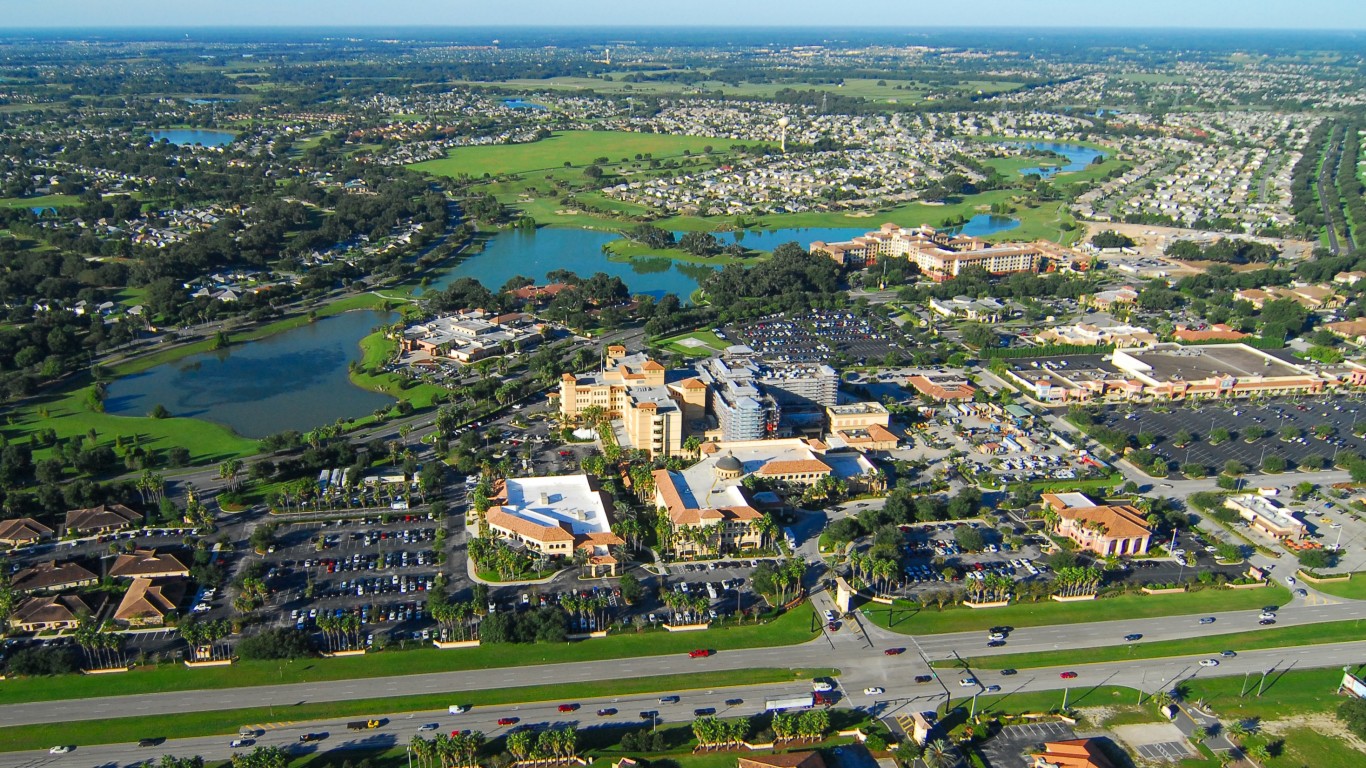
1. The Villages, FL
> Poverty rate of full-time workforce: 4.4%
> Official poverty rate: 9.2% (bottom 10%)
> June 2019 unemployment rate: 4.9% (top 20%)
> Avg. workweek: 36.4 hours (bottom 10%)
The Villages is a retirement community that constitutes the bulk of the population of Sumter County. Just 34.5% of the population aged 16 to 64 works in full-time, year-round jobs, the smallest share of any U.S. metro area.
For the minority of workers who work full-time, many work in the low-paying jobs in the retirement industry. Some 25.0% of workers are employed in education and health services, and 9.5% are employed in leisure and hospitality — each among the largest share of any city. The average wage for workers in the education and health services and leisure and hospitality sectors are $835 and $405 a week, respectively, far less than the $1,101 average pay for all workers nationwide.
Methodology
To determine the cities where having a job does not keep you out of poverty, 24/7 Wall St. measured the ratio of the official poverty rate to the poverty rate among full-time, year-round workers aged 16 to 64 in metropolitan areas using five-year data for 2013 to 2017 from the U.S. Census Bureau’s American Community Survey. The cities on this list are those where the ratio is the smallest.
Data on the mean hours worked per week, median household income, and the share of adults aged 25 and over with at least a bachelor’s degree also came from the ACS. Data on unemployment came from the Local Area Unemployment Statistics program of the Bureau of Labor Statistics and are seasonally adjusted for June 2019. Data on employment and average weekly wage by industry came from the Quarterly Census of Employment and Wages program of the BLS and are for 2018.
Credit card companies are pulling out all the stops, with the issuers are offering insane travel rewards and perks.
We’re talking huge sign-up bonuses, points on every purchase, and benefits like lounge access, travel credits, and free hotel nights. For travelers, these rewards can add up to thousands of dollars in flights, upgrades, and luxury experiences every year.
It’s like getting paid to travel — and it’s available to qualified borrowers who know where to look.
We’ve rounded up some of the best travel credit cards on the market. Click here to see the list. Don’t miss these offers — they won’t be this good forever.
Thank you for reading! Have some feedback for us?
Contact the 24/7 Wall St. editorial team.